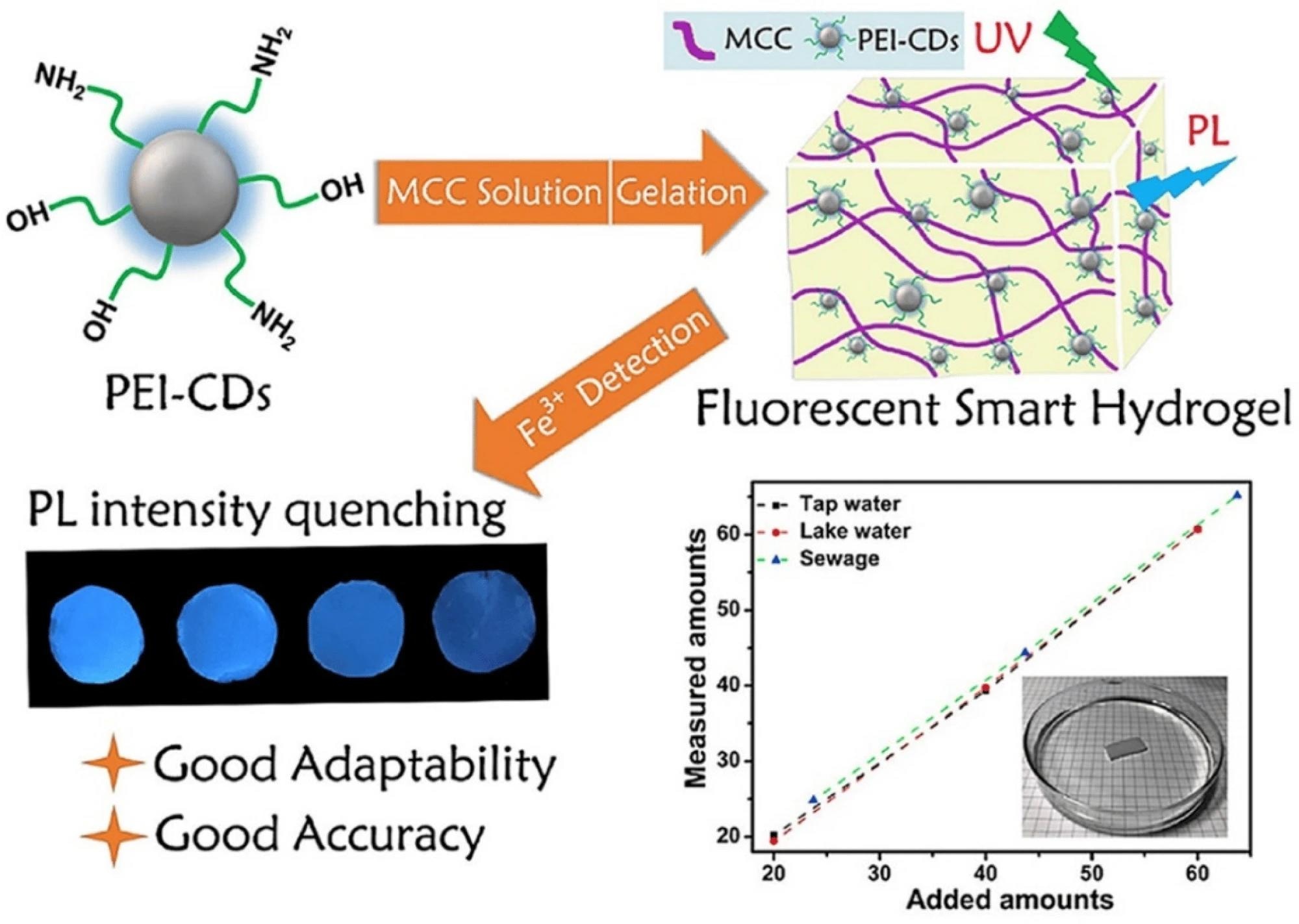A paper recently published in the Journal of Composites Science reviewed the diagnostic, biomedical, and environmental applications of quantum dot (QD)-enhanced hydrogel composites.
 A schematic representation of smart carbon dots (CDs), polyethyleneimine-modified carbon dots (PEI-CDs), within a microcrystalline cellulose (MCC) hydrogel for stable Fe3+ ion detection for photoluminescent (PL) performance [3]. Image Credit: https://www.mdpi.com/2504-477X/8/6/203
A schematic representation of smart carbon dots (CDs), polyethyleneimine-modified carbon dots (PEI-CDs), within a microcrystalline cellulose (MCC) hydrogel for stable Fe3+ ion detection for photoluminescent (PL) performance [3]. Image Credit: https://www.mdpi.com/2504-477X/8/6/203
Background
The incorporation of QDs, such as cadmium telluride (CdTe), cadmium sulfide (CdS), and zinc oxide (ZnO), and other nanomaterials, such as inorganic nanoparticles and carbon dots, is crucial for improving the electronic and optical characteristics of hydrogels. Specifically, nanoparticles are embedded while synthesizing composite hydrogels to enhance their photocatalytic efficiency, sensing abilities, and mechanical strength.
The trend towards synthesizing composite and hybrid hydrogels indicates the growing importance of multifunctional materials, which demonstrate enhanced performance in different applications, including energy harvesting, environmental remediation, and medical engineering.
Improved functionalization is realized using materials like black phosphorus QDs and carbon QDs to improve aspects like therapeutic effects and fluorescence, which are crucial in biomedical and medical applications such as cancer therapy, biosensing, and drug delivery.
For instance, new hydrogel membranes and magnetite/hydrogel/QD composites are suitable for drug delivery and therapy. Similarly, quantum-dot-enhanced photocatalytic systems for hydrogen production and hydrogels tailored to dye adsorption can benefit energy and environmental solutions.
In this paper, the authors reviewed different applications of QD–hydrogel composites, specifically the biomedical, diagnostic, and environmental applications.
Environmental Applications
A supramolecular hydrogel derived from bis-(urea), graphene QDs (GQDs), phenylalanine, and enzymes has been engineered to detect the organophosphate pesticide, dichlorvos. This hydrogel combines the catalytic properties and high surface area of GQDs with the specificity of enzymes, leading to enhanced dichlorvos detection sensitivity.
The authors discuss the synthesis of hydrogels embedded with CdTe QDs for fluoride-responsive sensing using an ion exchange synthesis method. These hydrogels exhibit a visible sol-gel transition specifically responsive to fluoride ions, offering a novel method for selective fluoride detection.
The incorporation of CdTe QDs into hydrogel matrices results in materials with exceptional fluorescence properties and quick response to fluoride ions, making them suitable candidates for water quality assessment and environmental monitoring. Hybrid materials created by integrating carbon QDs into hydrogel matrices can detect iron ions selectively and sensitively. These hybrid fluorescent hydrogels serve as a stable and robust platform for detecting iron ions in aqueous environments.
Additionally, the innovative use of carbon QDs in these hydrogels establishes a novel ion detection method in water. Similarly, poly(acrylamide-co-acrylic acid) hydrogels containing GQDs have also been synthesized for iron ion detection. In these nanocomposite hydrogels, GQDs act as crosslinking agents, improving the hydrogels' mechanical strength and enabling selective iron ion detection.
Diagnostic and Biomedical Applications
Chiral carbon dots (G-dots) derived from guanosine 5'-monophosphate (Na2(5'-GMP)) have facilitated the development of supramolecular hydrogels. These hydrogels, formed through fluorescent G-dot self-assembly, demonstrate the potential of guanosine derivatives in developing advanced biomaterials.
The resulting hydrogels display excitation-dependent fluorescence, which is suitable for bio-imaging applications. This feature allows for versatile imaging capabilities, enabling the visualization of biological structures and processes in novel ways.
Zinc sulfide (ZnS) nanocrystals, capped with (3-mercaptopropyl)-trimethoxysilane and incorporated into a polyacrylamide hydrogel, display stabilized fluorescence emission, advantageous for biomedical applications. This combination stabilizes the ZnS nanocrystals within the polyacrylamide hydrogel matrix, ensuring stable long-term fluorescence.
This stability is crucial for medical applications where reliable and consistent fluorescence emission is required over time. A biodegradable and injectable nano-photothermal DNA hydrogel incorporating black phosphorus QDs has been formulated for tumor therapy. This hydrogel enhances penetration and treatment efficiency in the tumor microenvironment. A reduction in drug resistance and improved survival rates are major benefits of this approach in cancer treatment.
A hydrogel consisting of GQDs-ε-PL@4-arm poly(ethylene glycol) (PEG)-BA/QCS was recently fabricated through dynamic imine bonds. The hydrogel features a surface enriched with GQDs-ε-PL amino groups to realize chemo-photothermal antibacterial activity.
The authors noted that including 4-arm PEG-BA/QCS and GQDs-ε-PL in the hydrogel enhanced antibacterial efficacy and facilitated dynamic self-healing. The hydrogel also displayed a rapid sol-to-gel transition. The potent antibacterial capabilities and rapid sol-to-gel transition play a critical role in efficiently sealing wounds.
A polyacrylonitrile conduit integrated with GQDs and a fibrin hydrogel has also been developed to improve nerve regeneration by leveraging the Schwann cells' supportive role in healing sciatic nerve injuries in rats. In nerve regeneration, this development has been realized by implementing a three-dimensional (3D)-printed hydrogel conduit. The conduit, consisting of 3D-printed polyacrylonitrile with fibrin hydrogel and GQDs, was applied to a sciatic nerve injury model, leading to enhanced sensory and motor functions and significant nerve recovery and regeneration.
Overall, this review demonstrates significant advances in hydrogels with the incorporation of QDs. However, more research is needed to address challenges such as scalability and long-term stability for their broader application and commercialization.
Journal Reference
Omidian, H., Wilson, R. L. (2024). Enhancing Hydrogels with Quantum Dots. Journal of Composites Science, 8(6), 203. https://doi.org/10.3390/jcs8060203, https://www.mdpi.com/2504-477X/8/6/203
Disclaimer: The views expressed here are those of the author expressed in their private capacity and do not necessarily represent the views of AZoM.com Limited T/A AZoNetwork the owner and operator of this website. This disclaimer forms part of the Terms and conditions of use of this website.